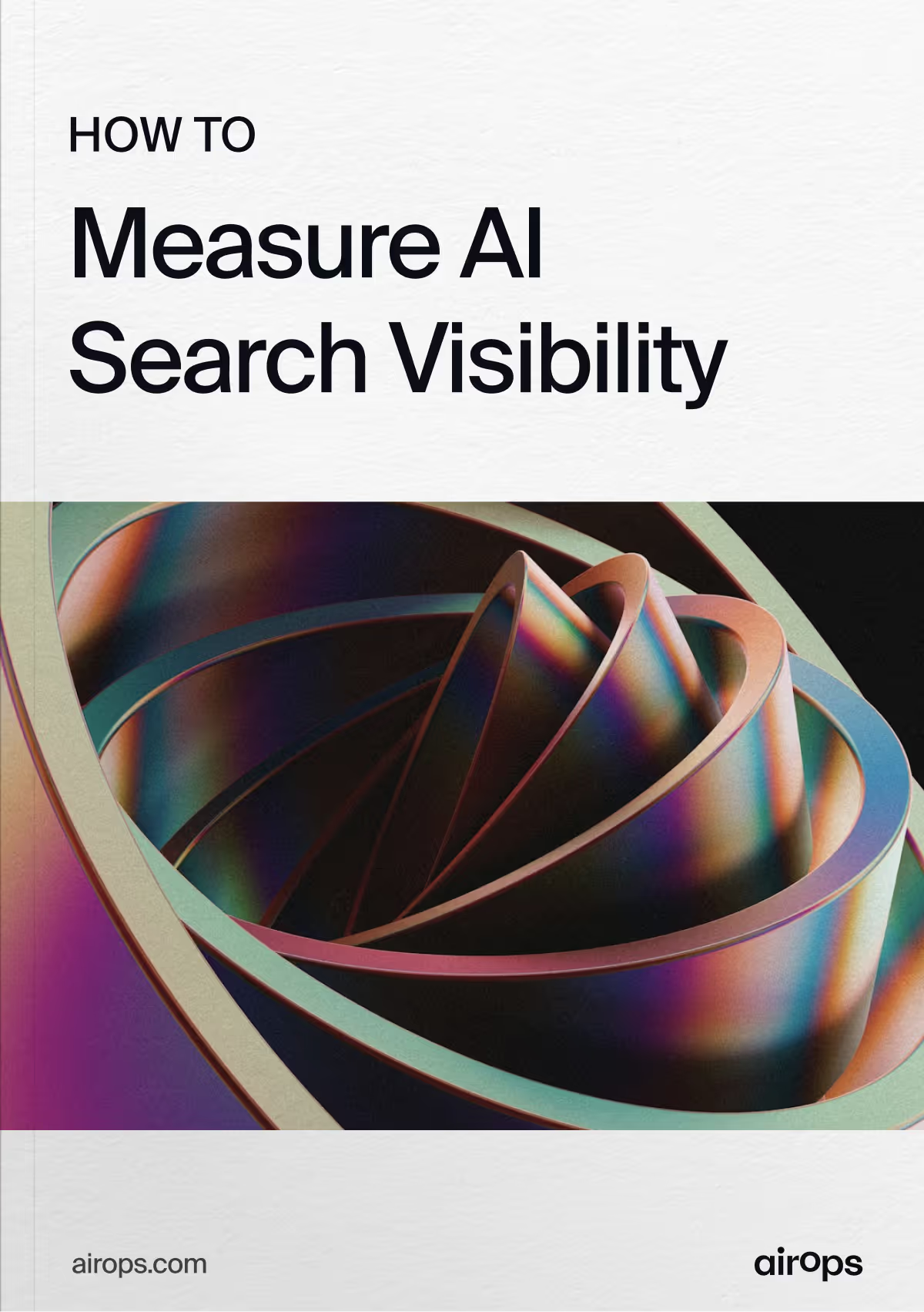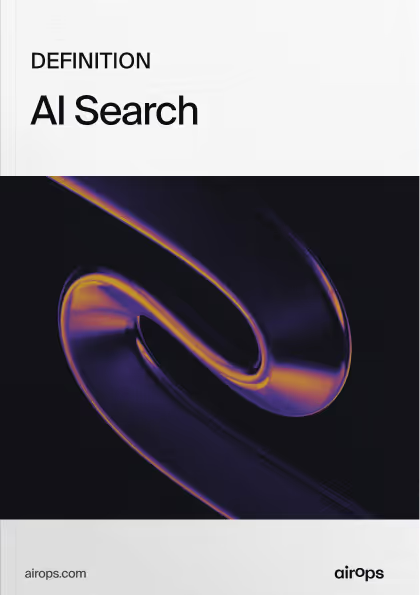How to Measure AI Search Visibility: Step-by-Step Guide for 2026

- Measure AI visibility by tracking brand mentions, citations, and share of voice across major AI platforms using structured analytics and systematic monitoring.
- AI search engines prioritize fresh, up-to-date content—measuring visibility helps you spot when pages are losing traction so you can refresh them before rankings and citations drop.
- Learn how measuring visibility in answer engines can uncover high-impact opportunities to improve your brand’s presence and authority.
- Measure AI visibility by tracking brand mentions, citations, and share of voice across major AI platforms using structured analytics and systematic monitoring.
- AI search engines prioritize fresh, up-to-date content—measuring visibility helps you spot when pages are losing traction so you can refresh them before rankings and citations drop.
- Learn how measuring visibility in answer engines can uncover high-impact opportunities to improve your brand’s presence and authority.
- Measure AI visibility by tracking brand mentions, citations, and share of voice across major AI platforms using structured analytics and systematic monitoring.
- AI search engines prioritize fresh, up-to-date content—measuring visibility helps you spot when pages are losing traction so you can refresh them before rankings and citations drop.
- Learn how measuring visibility in answer engines can uncover high-impact opportunities to improve your brand’s presence and authority.
- Measure AI visibility by tracking brand mentions, citations, and share of voice across major AI platforms using structured analytics and systematic monitoring.
- AI search engines prioritize fresh, up-to-date content—measuring visibility helps you spot when pages are losing traction so you can refresh them before rankings and citations drop.
- Learn how measuring visibility in answer engines can uncover high-impact opportunities to improve your brand’s presence and authority.
Traditional SEO metrics like rankings and clicks no longer reflect true brand influence as AI search engines and answer engines dominate discovery.
Research from AirOps found that over 60% of Google searches now feature AI-generated answers, making legacy metrics increasingly obsolete.
The bottom line: If you aren't tracking your brand's presence in AI-generated answers, you risk losing visibility, trust, and pipeline to competitors who are already optimizing for this shift in search behavior.
Why Measuring AI Visibility Matters
Measuring AI visibility is the only way to understand and influence how often your brand is surfaced, cited, and trusted across answer engines. This metric is directly tied to buyer discovery, competitive positioning, and revenue in an era where AI answers drive buying decisions. AirOps recent research found that brands earning both a mention and a citation in AI-generated answers are up to 40% more likely to maintain ongoing visibility.
Measuring visibility delivers four key advantages:
- Direct pipeline impact: Brands cited in AI answers are discovered and trusted earlier in the buyer journey.
- Competitive benchmarking: Visibility metrics reveal where you’re winning or losing ground to competitors.
- Actionable optimization: Tracking citations and mentions helps you prioritize content refreshes and technical improvements.
- Leading indicator of influence: Visibility is measurable long before traditional attribution shows up.
According to AirOps, the Brand Visibility Score—answers mentioning your brand divided by total relevant answers—is now the North Star metric for AI search.
Factors that Influence AI Visibility
Several internal and external factors affect how visible your brand is in answer engines. Understanding these variables helps you interpret results and prioritize optimization efforts.
- Brand authority signals: Positive authority signals such as external citations, domain authority, and overall industry visibility directly influences citation likelihood.
- Content freshness: Pages that have been updated within the past 12 months are 2x more likely to earn citations.
- Technical optimization: Pages with rich schema and clear structure improve agent extractability.
- Competitive landscape: Dense, competitive verticals require more aggressive strategies to gain share of voice.
- Query intent alignment: Content should directly answers user questions and align with the users query intent.
Prerequisites: What You Need Before Starting
Before you begin, make sure you have access to the following:
- Google Analytics 4 (or equivalent)
- Basic understanding of analytics and traffic sources
- LLMs platforms such as ChatGPT, Gemini, Perplexity, or Claude
- Historical website performance data for baseline comparison
How to Measure AI Visibility
Once your prerequisites are in place, you can begin tracking how often your brand is surfaced, cited, and mentioned in AI-generated answers. The process below is designed for manual measurement — ideal for establishing a baseline, validating tool data, and identifying early opportunities.
For teams that prefer to automate, AirOps can handle tracking, monitoring, and competitor benchmarking across multiple AI platforms—turning raw visibility data into actionable insights without the heavy lifting.
1. Set Up Tracking Infrastructure for AI Traffic
Before you can measure visibility, you need an analytics setup that isolates AI-driven traffic from other channels. This ensures your data is accurate and easy to segment.
- Create custom channel groups in Google Analytics 4 for AI sources (e.g., chat.openai.com, gemini.google.com, perplexity.ai).
- Configure UTM parameters for tests and campaigns involving AI platforms.
- Set up tracking views or filters to separate AI-driven sessions from other referral traffic.
2. Establish a Baseline with Manual Testing
Document your current presence in answer engines to create a baseline for tracking growth and impact. In AirOps' recent research, we found that only 30% of brands remain visible in consecutive AI-generated answers, while just 1 in 5 sustain visibility across five runs—so establishing a robust, ongoing baseline is essential for accurate measurement.
Run industry-relevant queries across LLMs:
- Test 20–30 industry-relevant questions your customers typically ask
- Test both branded and unbranded queries
- Include direct competitor comparison queries (ie. "Is [brand] or [competitor] better for project management?")
Track a variety of metrics:
- Brand mentions (yes/no)
- Citation and mention quality (direct quote, paraphrase, or passing reference)
- Competitor co-mentions
- Source attribution (the source where your page is cited or mentioned)
- Answer sentiment (positive, neutral, negative)
Log results in a spreadsheet or dashboard, and estimate impressions by dividing AI-sourced traffic by the 2% CTR benchmark for AI answers.
How do I know if my brand is mentioned in ChatGPT responses?
Start by asking ChatGPT relevant industry questions and documenting brand mentions. For scale, use automated tracking tools like AirOps to monitor mentions across multiple queries and platforms.
3. Scale Measurement with Automated Monitoring
Manual testing gives you valuable insights, but it can't capture the full scope of your AI visibility.
To get statistically significant data and track changes over time, you need automated systems that can test hundreds of queries across multiple platforms consistently.
Deploy tracking tools: Choose automated AI visibility platforms like AirOps for comprehensive monitoring across LLMs, or build custom API integrations if you need specialized functionality.
Build a prompt library: Determine what queries your audience is searching for by analyzing real customer language from support tickets, sales calls, search console data, and social media discussions to ensure you're testing the questions your audience actually asks.
Establish monitoring cadence: Create a systematic schedule with daily scans for your most critical topics, weekly brand audits to track overall performance trends, and monthly competitive analysis to spot market positioning shifts.
Set up performance alerts: Stay ahead of visibility changes by configuring notifications for significant drops in citation rates, negative sentiment shifts, or when competitors suddenly gain share of voice in your key topic areas.
Which AI platforms should I prioritize for visibility tracking?
Focus on ChatGPT, Google AI Overviews, Perplexity, and Gemini as core platforms, then expand to additional AI platforms that align with your audience and industry vertical.
4. Benchmark Against Competitors
Measuring your own performance isn’t enough—you also need to understand how you stack up in your market. Competitive benchmarking highlights gaps and opportunities.
- Select strategic competitors: Choose 2-3 direct competitors and track their share of voice across AI platforms, focusing on co-mention frequency when brands appear together.
- Analyze performance trends: Collect 60-90 days of historical data to identify seasonal patterns, content decay rates, and competitor campaign impacts.
- Study competitor citation sources: Review which page types (product pages, blogs, case studies, FAQs) earn your competitors the most citations to identify content gaps.
- Create competitive dashboards: Build competitive dashboards that map your visibility, citation frequency, and sentiment over time, with competitor data layered in for context
5. Update Content for AEO
Focus on the factors that most influence AI citations, from structure and schema to clarity and authority. Ongoing optimization is critical to maintaining and increasing visibility as AI models and answer engines evolve.
Analyze citation patterns to identify your highest- and lowest-performing pages.
Focus your analysis on:
- Pages with declining citation rates over the past 60 days
- Topics where competitors consistently dominate mentions
- Content with outdated statistics, case studies, or research data
Once you've identified your optimization targets, implement these content improvements to increases your chances of earning a citation.
- Refresh content with current information: Update outdated pages with fresh data, current statistics, and authoritative sources to position your content as the most authoritative, up-to-date resource.
- Enhance technical structure: Strengthen schema markup implementation and maintain clear, sequential heading hierarchies (H1 > H2 > H3) that make it easier for AI systems to parse and extract information.
- Improve content extractability: Add FAQ sections, bullet lists, and concise answer blocks that directly address common questions while improving both E-E-A-T signals and LLM citation potential.
In our latest research at AirOps, we found that pages with rich schema are 13% more likely to earn AI citations, and sequential heading structures boost citation odds by 2.8x.
Measure the impact of your optimizations by tracking shifts in citation share, sentiment, and share of voice for queries tied to the updated page’s content. This ensures you can connect specific changes to measurable visibility gains.
How Often Should I Check AI Visibility Performance?
Use automated daily monitoring to capture fluctuations in ai search, with a manual review at least once a month for accuracy. For updated pages, re-run your query set every 7 days to detect early changes in generated responses and citation patterns.
Common Measurement Mistakes to Avoid
Avoiding these mistakes will save time, prevent false conclusions, and ensure your brand visibility is measured accurately and produces actionable insights.
- Tracking only one platform: Limiting measurement to ChatGPT or Google AI hides 60–70% of your true visibility footprint. Monitor all major answer engines from day one.
- Relying solely on manual spot checks: AI responses fluctuate. To get statistically valid data, run 50+ queries per topic across platforms and track results over time.
- Failing to capture AI referral traffic: Without custom channel groups and UTM parameters, AI-driven visits get lost in generic referral data — skewing your analytics.
- Publishing content AI can’t extract: Dense paragraphs, missing headings, or unstructured layouts make it harder for answer engines to parse and cite your content.
Turn Measurement Insights Into Action
The brands winning in AI search aren’t just tracking their presence—they’re acting on it. The gap between measurement and execution is where competitive advantage is built.
With AirOps, you can:
- See where your brand is—and isn’t—appearing in AI-generated answers and identify citation gaps that limit your reach.
- Spot competitive threats early before they impact pipeline and share of voice.
- Pinpoint optimization opportunities with the greatest potential ROI.
- Take targeted, high-impact actions to improve extractability, authority, and relevance.
- Monitor the impact of changes in real time across multiple answer engines.
Secure your place in the answers that matter most. Book a strategy session to learn how AirOps can help your brand turn visibility into measurable growth.
Win AI Search.
Increase brand visibility across AI search and Google with the only platform taking you from insights to action.
Table of Contents
Get the best and latest in growth and AI search delivered to your inbox each week.




